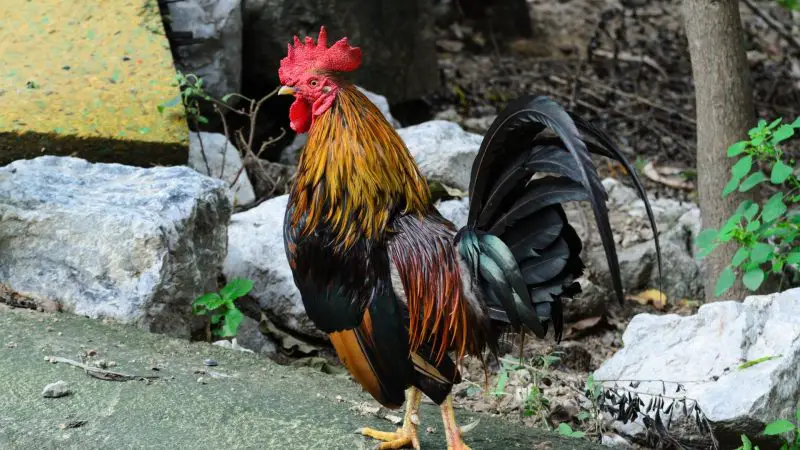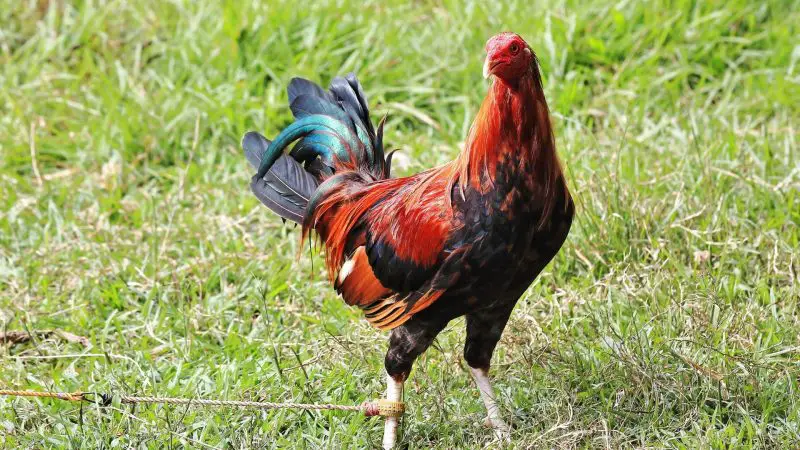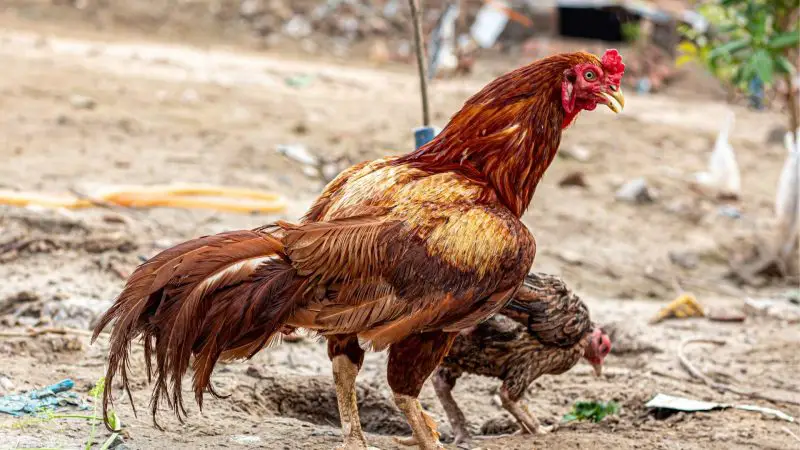Fighting roosters, also called gamefowls, are from chicken breeds with extremely aggressive behaviors and extraordinary combat skills. Some of them have been around for centuries and have retained their traits until today.
There are also new breeds of warriors, but with a very huge potential of establishing their names.
What are the different fighting rooster breeds? Among the well-known fighting rooster breeds are Albany, Asil, Hatch, Kelso, McRae, Radio, Roundhead, Sweater, and Whitehackle. All of them possess superb physical characteristics and excellent fighting styles. Most of them were developed by legendary breeders.
Cockfighting has been a popular sport for a long time in several countries in the world, especially in Mexico and in the Philippines, where it is legal, but you should first secure a permit.
Choosing the right breed of gamefowls can be challenging. To help you out, below are 12 chicken breeds that produce winning fighting roosters.
12 Fighting Rooster Breeds
1. Kelso

The majority of Kelso fighting roosters have a straight comb, yellow feathers over the head and neck, turkey crests, and yellow or white legs. However, most buyers prefer those with white legs.
Considered one of the best fighting cocks in the world, Kelso fowl has various bloodlines such as Johnnie Jumper and Out & Out.
This large American game bird was developed by Walter A. Kelso (1892-1964) of Galveston Island, Texas. It is a known breed and owner of Oleander Gamefarm.
Instead of using pure breed, he decided to crossbreed different winning cocks, including Clarets, Madigin Grays, Texas Rangers, and Typewriter cocks.
Kelso fighting cocks are very famous for being smart ground fighters. These classic gamefowls don’t usually jump into the air to attack their opponents. Instead, they shuffle or sidestep and launch an attack.
Then, they use their power and speed to win with flying colors. Amazingly, most Kelsos today are deadlier.
2. Roundhead
Roundhead gamefowls have pea combs, red eyes, and black spurs. These medium-to-large slashers weigh 2-2.4 kilos and possess pale yellow hackles and yellow or white legs.
The fighters that belong to its family include the Allen, Boston, Bruners, Sheltons, and the most famous among them, Lacy Roundhead.
Roundhead fighting roosters have Asian roots, which is why they are considered Asian gamefowls instead of American gamefowls.
The originator of Boston Roundhead is John Hardwood, sometime in 1864, while the originator of Lacy Roundhead is Judge Ernest Lacy of Jasper, Alabama, sometime in 1916.
Roundheads are known for having a natural killer instinct and cutting deep on their opponents. These fast flyers also have superb leg power, as well as very intimidating side-stepping abilities.
Moreover, these strengths were shared by the Kelsos since Walter Kelso crossed them with Clarets to develop the McClanahan.
3. Sweater

The Sweater gamefowl is a very famous winningest breed of fighting roosters that has ever been developed. These aggressive gamefowls are usually orange-red to light red and have red breasts, long white feathers on tails, and yellow legs.
Among its popular strains of today are Blackwater and Possum Sweater 226.
The first Sweater fighting cocks were developed by Carol Nesmith, owner of Black Water Farms in Alabama. Despite not being its originator, he is credited for successfully improving the fighting traits of Sweaters.
He also hooked up with Nene Abello, a world-renowned gamefowl champion from the Philippines.
Unlike the earlier strains of Sweaters that lack endurance, Sweaters of today are among the most feared opponents in derbies, especially in Mexico and in the Philippines.
This slasher fighting cock breed is famous for its relentless attacks in the air and destroys its opponents on the ground through submission.
4. Hatch
There are several variants of Hatch gamefowls, which include Leiper Hatch, Sylvester Hatch, Yellow-legged Hatch, McLean Hatch, and Blueface Hatch.
Each of them has a unique color distribution, but all of them have yellow or yellow-green legs. Most of these fighting roosters are known for being deadly cutters.
The Hatch fighting rooster is named after its originator, E. Sanford Hatch, a legendary gamefowl breeder and a long-time member of the New York Stock Exchange.
He produced the Hatch by mixing several bloodlines such as Jim Thompson Mahogany, Herman Duryea (Boston Roundhead), among others.
In general, all Hatch varieties are very aggressive and extremely powerful with no-holds-barred attitudes. However, a pure McLean Hatch is considered low-headed, poor cutter, and lost in some of its fights.
Nevertheless, modern Hatches are fast fighters and have very powerful legs and good endurance against pain.
5. Shamo

The Shamo chicken breed was initially developed as a gamefowl and comes in various sizes and colors, depending on the strain. O-Shamo gamefowls are large and weigh about 12.4 lbs.
They are medium-sized and weigh about 8 lbs. On the other hand, Kimpa-Shamos are small and weigh only about 4 lbs.
In general, Shamo gamefowls have a pea-shaped comb, muscular bodies, and a superior fighting mode.
Shamos originated in Japan and were believed to have been brought from Thailand (then known as Siam) during the early years of the 17th century. They are available in the US but mostly in the southern states only.
Since Shamo chickens are strains of Asil chickens, they have similar fighting styles. These aggressive gamefowls are very hostile towards each other.
Their hens and baby chicks also attack each other when confined in the same place. This behavior has made them become excellent fighting roosters.
6. Radio
Radio fighting roosters are medium-sized gamefowls with dark red or light orange feathers, serrated crest, and yellow-green, powerful legs.
Among their most obvious characteristics are being cheerful and very noisy. This is the reason why Johnny Jumper, who developed them in 1962, named them “Radio.”
The original Radio bloodline was believed to have come from a female Whitehackle and a male Murphy that was crossed with a Kelso hen. Then, their offspring were bred back with 7/8 of the Radio breed.
Apparently, this gamefowl breed is difficult to cross, and crossing with Kelso or a Sweater is recommended.
Radios are known for being slow and not intelligent fighters because they only attack in one direction – forward. But still, they usually make the first hit, which made them enjoy a winning streak back in the 80s and 90s.
These talkative birds fight very fast. So, when the opponent is down, they hit multiple times until the end.
7. Asil

They have short, red, and black feathers, yellow legs, and broad shoulders. These fighting machines are heavy muscled and weigh between 4lbs and 6lbs. Their athletic body is valued for stamina.
In general, Asil chickens have a small pea comb, no wattles, an upright carriage, and yellowish skin.
The Asils originated in India and have been bred as tough fighting roosters. They have been around for more than 2,000 years, making them one of the oldest known breeds of gamefowls.
Having an inborn desire to fight, even the females and their young also have a pugnacious temperament with no plans of giving up.
The Asil’s fighting style is somehow uncommon but very dangerous. These muscular gamefowls use natural spurs (not fake), powerful legs, and very strong beaks.
Despite being slow due to their heavy bodies, Asils can easily subdue their opponents. Aside from being cruel attackers, they are also good in defense.
8. Black McRae
McRae gamefowls are black-feathered roosters with a mulberry face, dark red eyes, and black legs. An outstanding variety of this chicken breed is the red version called Gilmore McRae.
Black McRae was very popular in the US from the 60s to the 80s after beating tough opponents in their long-knife slasher fights.
William Mcrae developed the Black McRae through a three-way cross of a Kent Mug gamefowl (black Mugwump), a Sheldon Black Roundhead, and 1/8 Blueface Hatch.
He was also among the first breeders who have shipped his discovery from the US to the Philippines and sometime during the Korean War.
In terms of fighting style, the McRaes are known for not initiating a blood fight. Instead, these gamefowls patiently let their opponents strike ahead. Then, they throw a very strong counter punch that cripples the enemy.
This smart counter-attack tactic by the McRaes has made them very successful fighters.
9. Albany
Albany fighting roosters are usually light red and have black breast splashed with ginger color. They have a round head, a pea comb, and yellow legs.
The Reb Williamson Albany gamefowl, which weighs about 5 – 5 ½ lbs, is a smart striker and very active inside the ring. At some point, a strain was called “The Sneak.”
As the name suggests, the Albany gamefowl was developed in Albany, New York, sometime in the 1930s by the O’Connell brothers.
The Old Albany was believed to have a huge percentage of the bloodlines from Stanford Hatch and Hardy Majoveni. Since then, the family spread pretty quickly across the United States.
Being intelligent fighters, the Albanies wait for their enemy to make the first move. Then, they counterattack by ducking under their opponent in the air even before the attacker can connect.
This amazing fighting technique has been a signature for the modern Albanies despite being crossed with different breeds.
10. Whitehackle

Whitehackle gamefowls have red eyes, a straight comb, and a heavy yellow-red plumage. They also have medium-sized bodies, broad shoulders, and weigh 2-2.4 kilos (4.4-5.3 lbs).
Despite their beauty and elegance, these classic warriors are fearless inside the ring. They are also dubbed as ‘ring generals.’
Whitehackles are believed to have originated in Ireland and England. Meanwhile, among the famous strains are Kearney Whitehackle, which was developed by Floyd Gurley, who bred them from the original strain of Michael Kearney, and the Morgan Whitehackle by Col. William I. Morgan of East Orange, New Jersey.
Whitehackles are known for being strong hard-hitters and deadly cutters. These vicious warriors know the perfect time to attack and engage from any available position.
They can also read their opponents and can endure physical fatigue in long fights. To avoid being hurt badly, they fly high and later win vigorously.
11. Peruvian
The Peruvian gamefowl is usually brown-red, rumpless (no tail), and may have no feathers on their neck. They can weigh from 6 to 13 lbs, but their average weight is between 8 and 10 lbs.
These heavyweight but flighty slashers can have a single comb or a pea comb, but most of their strains have a straight comb.
Don Humberto Gregorio Pedraglio Oddone, who was born in Lima (Peru’s capital) on November 17, 1899, developed this unique bird sometime in the early 1900s.
It was developed by crossing several gamefowl breeds such as Old English Games, Belgian, and Spanish, along with Asil, Shamos, and Malay.
When it comes to battle, Peruvian gamefowls are fast, powerful, and have long-lasting endurance. However, it is not advisable to interbreed or crossbreed them with another Peruvian gamefowl species to produce a hybrid, especially if you are a newcomer. This technique has more risks than crossing American breeds.
12. Spanish Gamefowl
Spanish Gamefowl roosters are small to medium in size, weigh about 8 pounds (3.6 kilos), and belong to the hard feather category. Among its color varieties are black, lavender, and white, but it is very rare.
Generally speaking, this unique chicken breed is becoming rare, and only a few fanciers are now keeping them.
The history of Spanish Gamefowl is unknown, but Spain is unlikely the country of origin. Instead, many people believe that this rare fighting cock breed was brought to Europe by the Phoenicians, an ancient people who lived from 1500 to 300 BC. Since then, these Spanish roosters became supreme fighters.
Also called the fighter of Spain, Spanish gamefowls are very dominant and territorial. But because of their rarity, there’s only a little information about their fighting records and abilities.
Nevertheless, these fighting roosters were said to have the same fighting skills as the old types of Bankiva or Peruvian gamefowls.
Summary
The gamefowls mentioned above are among the greatest fighters but breeding them is not that simple. Every breeder uses their personal touch so the roosters can maximize their fighting skills.
In any kind of combat, gamefowls need special care, proper exercise, and complete nutrition. Otherwise, they can get killed.
